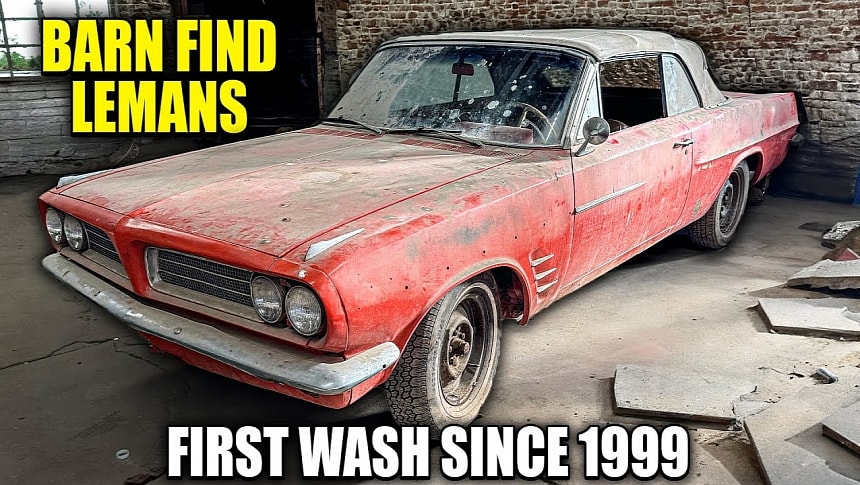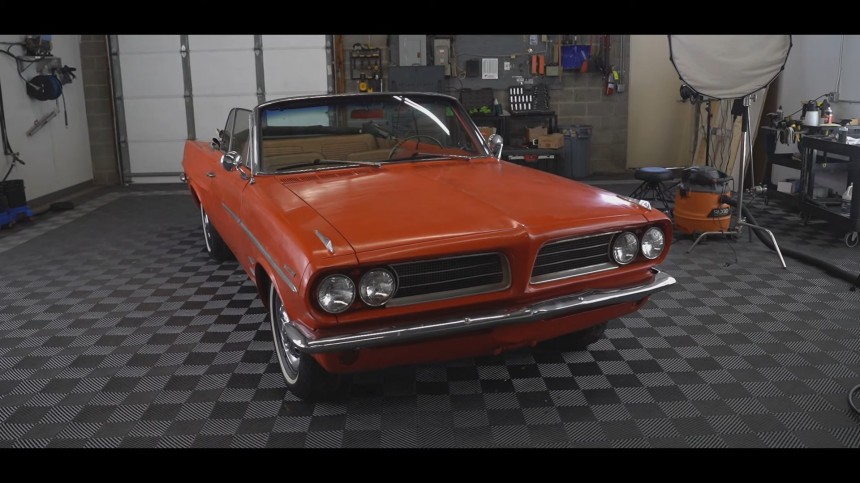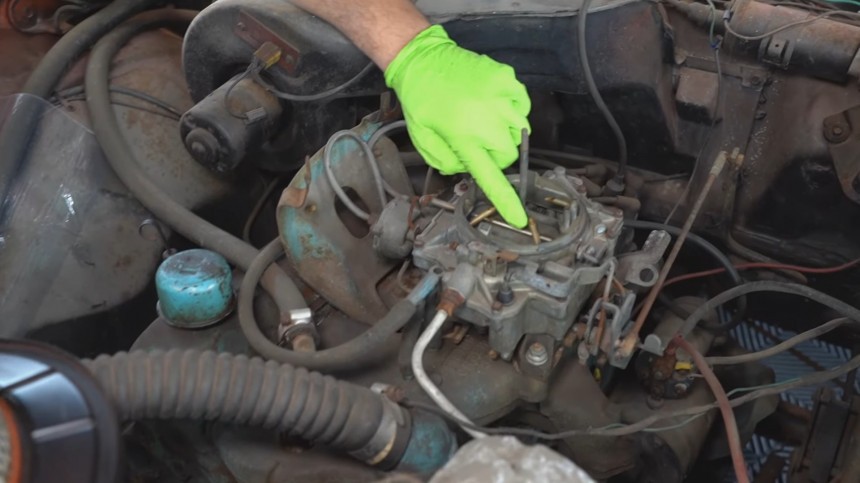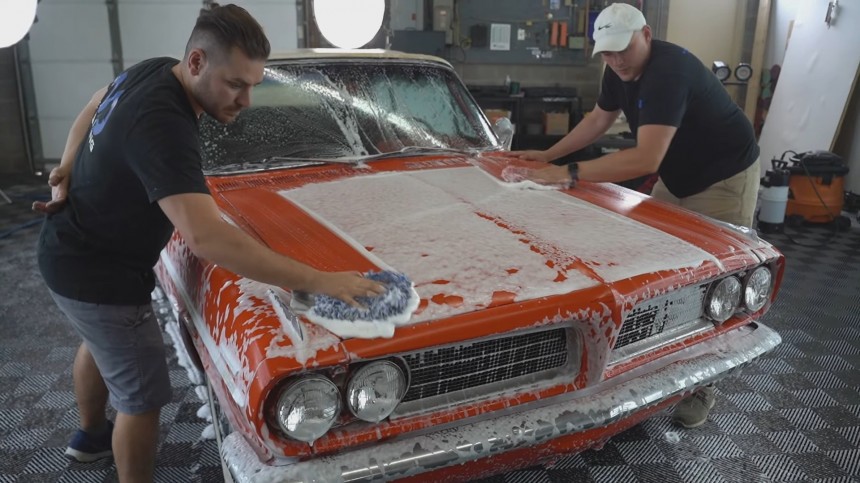Pontiac has been the oddball in the General Motors family, but not in a bad way. The division pioneered great ideas and concepts over the years. I'm not talking about the muscle car trend of the sixties. Even before the Collins-DeLorean-Gee trio shoehorned a 389-cube V8 sourced from the full-size line of Ponchos into the intermediate Pontiac Le Mans in 1963, PMD was exploring white spots on the map of American motoring.
Inevitably, when the name Pontiac is mentioned in any conversation regarding American carmaking heritage, everyone’s thoughts go to the GTO of 1964. It was the product of imagination, perseverance, stubbornness, and grit showcased by three enthusiastic Pontiac engineers. Bill Collins, John DeLorean, and Rus Gee are the main responsible gearheads who crafted the muscle car.
Their idea was to fit a 389-cubic-inch (6.4-liter) V8 motor (that was, by General Motors decree, offered only in the like of Catalinas, Bonnevilles, and the rest of the full-size nameplates) inside the mid-sized Le Mans, and call it a GTO. That was in 1963 – the GTO was launched in the fall of that year as a 1964 model, and all horsepower wars hell broke loose right there and then.
The receiver was a relatively new moniker, having arrived as a late-model-year trim level of the compact Tempest (that had itself debuted as a 1961 model). In 1963, the Le Mans became a model of its own and stayed that way until 1981. The first generation (’61-‘63) was the only one built on a compact platform. Beginning in 1964, the name was promoted to intermediate.
The Le Mans was available as a two-door coupe in its first year; in 1962, it expanded to droptops, and it also came with one of Pontiac’s quirky innovations: the first-ever mass-produced transaxle in America. A motor at the front sent torque to a rear-mounted gearbox through a thin and bent driveshaft. While the linkage between the engine and the transmission was a John DeLorean patent, the engine was another oddity.
The Tempests and Le Mans of the early '60s came standard with an inline-four-cylinder plant – or, more accurately put, half of a V8. Now, you might say that all straight-four engines are half of a V8, and you'd be right (mathematically). In Pontiac’s case, their ‘Trophy 4’ engine was literally the left-side bank (as seen from the front) of their trusted Trophy V8 motor. The small four-piston engine even kept the same 45-degree angle as it originally had in the eight-cylinder configuration.
The Trophy 4 was a Tempest-Le Mans-only motor offered only for the first generation on all trim levels and body styles. Interestingly, the small motor (displacing 194.5 cubic inches / 3.2 liters) allowed any fuel induction architecture from a thrifty one-barrel gas saver to the grown-up four-barrel carburetor, the standard equipment on the 389 Trophy V8.
With such a powerful incentive, the four-banger developed enough horsepower to run with the big boys. For example, in 1963, the last year of its production, it produced 166 hp and 217 lb-ft (168 PS, 294 Nm). The best part about it? It could be mated to a four-speed manual transaxle that offered nearly 50/50 weight distribution.
Coincidentally, one of those final-year Trophy 4-powered Le Mans just emerged from a long slumber in a barn (25 years, to be specific), ready to become a fun driver again. The car popped up in a body shop – the owner wants a full restoration of the vehicle for a very special purpose – but it needed a thorough cleaning before actual work could begin.
Enter Wagner DiCesare detailing gang from Cleveland, Ohio. The 1963 Pontiac Le Mans owner wanted a clean car to send to the restorers, so he approached the YouTubing trio with this request. The Poncho is to become the owner’s father’s new classic ride, with health issues preventing the senior gentleman from enjoying his full-blown muscle car joyrides.
As we can see, the Le Mans is not aesthetically in the best of shapes – the five-minute paint job on it is one indicator – but otherwise, it’s a clean, solid, straight, and most importantly, running and driving example. It’s also a drop-dead gorgeous droptop, so its new driver will definitely be in for a super-nice treat.
The Le Mans was a very popular model in its first year, with 61.658 examples assembled. Interestingly, unlike its Tempest sibling, the Le Mans was a much closer competition between the two engine choices – the four and the eight. Nearly 32,000 cars had the standard (and more economical) Trophy 4, and 29,689 came with the optional V8 (a 326-cube / 5.3-liter motor).
By comparison, the Tempest line saw a major rift between the four-cylinder production and the V8s. More than 46,000 had the inclined half-V8 out of a total of 69,000 Tempests assembled for 1963. Even though the unlikely engine was retired after just three model years, the Le Mans nameplate endured as a highly successful Pontiac offer for the rest of the decade, always staying above the GTO in sales numbers.
Their idea was to fit a 389-cubic-inch (6.4-liter) V8 motor (that was, by General Motors decree, offered only in the like of Catalinas, Bonnevilles, and the rest of the full-size nameplates) inside the mid-sized Le Mans, and call it a GTO. That was in 1963 – the GTO was launched in the fall of that year as a 1964 model, and all horsepower wars hell broke loose right there and then.
The receiver was a relatively new moniker, having arrived as a late-model-year trim level of the compact Tempest (that had itself debuted as a 1961 model). In 1963, the Le Mans became a model of its own and stayed that way until 1981. The first generation (’61-‘63) was the only one built on a compact platform. Beginning in 1964, the name was promoted to intermediate.
The Tempests and Le Mans of the early '60s came standard with an inline-four-cylinder plant – or, more accurately put, half of a V8. Now, you might say that all straight-four engines are half of a V8, and you'd be right (mathematically). In Pontiac’s case, their ‘Trophy 4’ engine was literally the left-side bank (as seen from the front) of their trusted Trophy V8 motor. The small four-piston engine even kept the same 45-degree angle as it originally had in the eight-cylinder configuration.
The Trophy 4 was a Tempest-Le Mans-only motor offered only for the first generation on all trim levels and body styles. Interestingly, the small motor (displacing 194.5 cubic inches / 3.2 liters) allowed any fuel induction architecture from a thrifty one-barrel gas saver to the grown-up four-barrel carburetor, the standard equipment on the 389 Trophy V8.
Coincidentally, one of those final-year Trophy 4-powered Le Mans just emerged from a long slumber in a barn (25 years, to be specific), ready to become a fun driver again. The car popped up in a body shop – the owner wants a full restoration of the vehicle for a very special purpose – but it needed a thorough cleaning before actual work could begin.
Enter Wagner DiCesare detailing gang from Cleveland, Ohio. The 1963 Pontiac Le Mans owner wanted a clean car to send to the restorers, so he approached the YouTubing trio with this request. The Poncho is to become the owner’s father’s new classic ride, with health issues preventing the senior gentleman from enjoying his full-blown muscle car joyrides.
The Le Mans was a very popular model in its first year, with 61.658 examples assembled. Interestingly, unlike its Tempest sibling, the Le Mans was a much closer competition between the two engine choices – the four and the eight. Nearly 32,000 cars had the standard (and more economical) Trophy 4, and 29,689 came with the optional V8 (a 326-cube / 5.3-liter motor).
By comparison, the Tempest line saw a major rift between the four-cylinder production and the V8s. More than 46,000 had the inclined half-V8 out of a total of 69,000 Tempests assembled for 1963. Even though the unlikely engine was retired after just three model years, the Le Mans nameplate endured as a highly successful Pontiac offer for the rest of the decade, always staying above the GTO in sales numbers.

































































